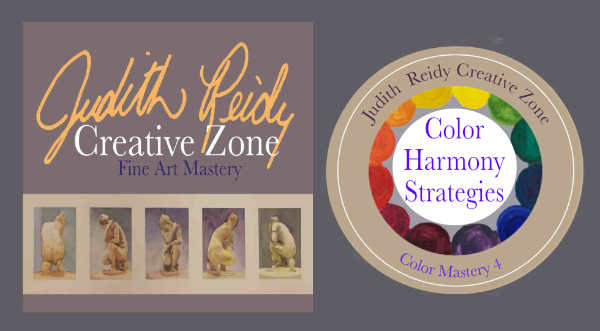
Color Harmony Strategies

Harmony Makes the Magic Music in Painting
ONLY
$575 $199
Know Color Strategies that
Put Color Magic into your painting!
Harmony Makes the Magic Music in Painting
-
-
- Do your paintings lack pazazz!
- Do you use the same boring colors?
- Do you struggle to create the mood you want in in a painting?
-
Color Harmony Strategies is Part 4 will help you understand
-
-
- How to discover color combinations to create various moods in a painting.
- How to expand your color repertoire and expand your vision
- How to stretch your color sense and utility
-
After you Complete Color Schemes Part 4 you will…
-
-
- Understand and Use the Three Major Color Harmony Methods,
Completely practice creating harmony using 6 major color schemes - Monochromatic, Analogous, Complementary, Split complementary, Quadratic, and Triadic
- You will have a color mixing framework to create any mood
- You will know when to use earth, mineral and modern color pigments to create the color you want.
- Understand and Use the Three Major Color Harmony Methods,
-
Confidently select new color combinations that excite the eye and the imagination
In Color Harmony Strategies Part 4
Unlock the Power of Color Harmony
In Part 4 of this series, you’ll gain crystal-clear strategies to build stunning color combinations from a limited palette. Whether you work with traditional pigments or modern hues, you’ll learn how to confidently select and mix colors that ignite emotion, create balance, and resonate with your artistic voice.
No More Guesswork or Wasted Paint
Discover how a small, intentional set of pigments can produce an infinite range of beautiful mixtures — without muddy results. This approach saves time, cuts waste, and gives you predictable, inspiring outcomes every time you paint.
Feel Supported and Empowered
You won’t go it alone. You’ll be part of a supportive online community with Q&A access, detailed demonstrations, and step-by-step exercises that cement your understanding and your skill.
Here’s How You’ll Master Color Harmony
Step 1: Understand the 6 core schemes (monochromatic, analogous, complementary, etc.)
Step 2: See real examples using traditional and modern pigments
Step 3: Apply them in simple studies that translate to finished paintings
Step 4: Build confidence to choose and mix your own palettes
Our simplified method, you’ll never feel lost in a sea of color again.
Color will finally make sense — and feel like second nature.
Confidently select new color combinations that excite the eye and the imagination.
Worry No More….
To play with color and saturation. I really like the detailed nuts and bolts analysis ... It really was useful to see what ... were doing and how work evolved.
I liked the analysis of the works in progress and ideas about how to proceed, alternatives and suggestions. It was enjoyable to hear the narrative behind the work.
-Cheers,
Ken
I can only tell you that I thought your classes were enjoyable and if we needed you would always give us the help we needed. Otherwise I remember it was enjoyable to sit and paint …..I think overall your attention to the students is a great help.
I really enjoyed understanding the ways to mix colors as to how the difference is if you mix warm and cool primary colors together to get different types of secondary colors. It has helped me out a lot with how I paint now.
Dear Judith
First off, let me tell you I am a fan of yours.
Thank you for your kindness in understanding my mistake and correcting it. I am very appreciative.
Thank you for your personal attention.
Cheers
Terry
I liked your classes,...Skill of painting and knowledge of technique Loved your style and expertise -Loved relaxed atmosphere... care

